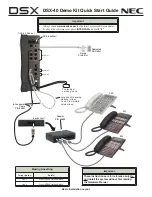
MERLIN LEGEND Communications System Release 5.0
Feature Reference
555-650-110
Issue 1
June 1997
Features
Page 527
Remote Access
summarizes the ways that remote access is made available to callers,
depending upon the type of line/trunk and the routing used on that line/trunk.
Table 38.
Remote Access Routing
For more information, see
‘‘Primary Rate Interface (PRI) and T1’’ on page 441
.
User Interaction
3
8
Beginning with Release 3.0, a caller has three chances to enter the correct barrier
code. An inter-digit time-out occurs during the first attempt, even if the dialed
digits are incorrect. The system only processes the valid number of digits. A dial
tone is given after the correct code is entered. If the caller enters more than the
correct number of digits, the system uses the time-out to hide the correct number
of digits. The time-out recurs until the caller has dialed the eleventh digit—giving
the impression that additional digits are required—even if the barrier code length
is shorter. A distinctive tone sounds after an incorrect entry. After three incorrect
entries, the system disconnects the caller.
The following steps describe a remote access call.
1.
The caller dials into a line, described above, that accepts remote access
calls. Personal lines light steady green.
2.
If a barrier code is not required, the caller hears a dial tone and proceeds to
Step 4.
3.
If a barrier code is required, the caller dials the code.
A barrier code cannot begin with
*
(star) or contain two
*
s:
Routing
Facility
User Dials
Facility Remote Access
Programming
Line
Loop-start, ground-start,
emulated loop- or
ground-start, BRI, PRI
B-channel group
programmed for line
routing, automatic-in tie,
emulated automatic-in tie
Telephone number Must be programmed for
dedicated or shared remote
access.
Not routed Dial-in tie or emulated
dial-in tie
Remote access
code
None
Dial-Plan
DID or emulated DID, PRI
B-channel group
programmed for dial-plan
routing
Telephone number
including remote
access code
System must be programmed to
add or delete digits to or from
dialed telephone numbers
received, so the remote access
code is received.
















































